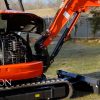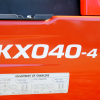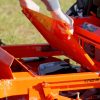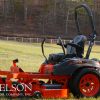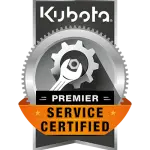Warning to our readers: Nelson Tractor Company’s blog posts are intended to give you tips on what works best based on our opinion. We strongly recommend consulting on your owners’ manual as the ultimate guide.
When transporting equipment like tractors and mowers, it is extremely important that the machines are securely tied down. If they are not, you are at risk for dangerous accidents that could result in equipment damage, injury to you or people in the surrounding area, and even death. It is your responsibility to make certain that the equipment you are moving is properly and firmly tied down for safe transit.
Each piece of equipment will have its own specific requirements for safely tying down and hauling, however, there are certain general procedures to remember that apply to all equipment.
Careful, it’s heavy
First, you need to be aware of the load rating of the trailer you are using to haul, and the weight of the equipment being moved. The load rating will be located on the trailer identification plate or in the operator’s manual, and your manual will have the equipment weight.
It is also very important not to overload the trailer or any of the individual axles to avoid tire damage, axle failure, and bearing failure. Extra weight affects handling, acceleration, and braking, so you’ll need to be careful, especially when braking or making turns.
To avoid overloading, your trailer must have the capacity to carry the weight of the equipment you are hauling plus the weight of the trailer itself.
Tying it down
Weight of equipment is also how you determine how many tie downs are needed to secure your load, as well as their capacity. The primary requirement is that the tie downs must have the strength at least equal to 50% of the weight of the load being hauled. If you’re moving a 1,200 lb zero-turn mower, for example, you’ll need at least two ties rated for at least 600 lbs.
If you’re transporting heavier equipment, like a shiny new John Deere 7425, you could be looking at upwards of 12,000 lbs. Forget the ties, get chains rated for 6,000 lbs to properly tie it down. That’s at least two ⅜ chains with a rating of 70 or higher, and make sure the hooks are of equal quality.
Spot Check Before Use
Examine all chains before each use and remove any that appear to be chipped, cracked, or links that are stretched or worn. If you’re using ropes, straps, or webbing, look for signs of wear or weakness.
Also check tie down points, hooks, binders, and clevis pins to confirm that they meet regulations.
To be safe, you should regularly pull over and check the security of the load and make sure everything stays in its designated place. Straps and chains can move, stretch and shift during transit, so it is important to reinspect them at points during the trip.
Controlling the Weight
Weight distribution is important to understand and consider when tying down equipment. It’s important to distribute the weight of the load evenly. If too much weight is placed in the front, it can make steering less responsive. Too much weight in the back can affect braking and decrease traction, along with also affecting the steering. The trailer can ‘fishtail’ if weight is not evenly distributed, making it virtually uncontrollable. The best way to ensure that the distribution of weight is even, is to inspect the suspension and make sure it is even all around.
Avoiding damage is also important when tying down your equipment. Pay attention to securement points located on the machine and trailer. Tying down at a 45 degree angle is the best way to use chains to perform at the highest working load. A flat chain is not as strong as one at an angle.
Securing your equipment is just as important whether you’re traveling across the country or half mile down the road to a job site. Don’t cut corners when going only a short distance. You never know when your expensive equipment, your safety, and the safety of everyone on the road around you may depend on how well your mower, tractor, or skid steer is secured.



